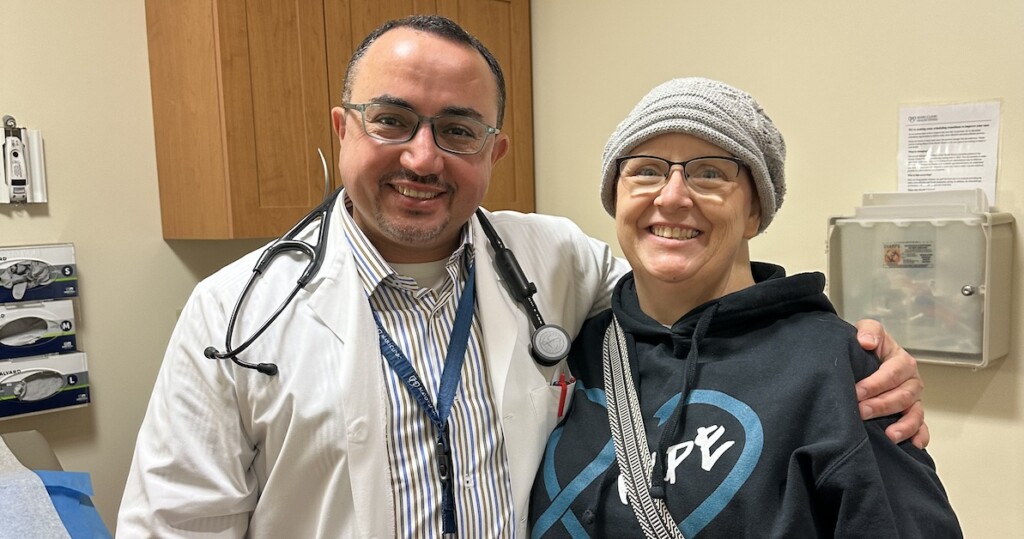
Gynecologic Cancers
Recognizing the interconnectedness of ovarian and all gynecologic cancers, OCRA expanded its scope in order to accelerate research and broaden our impact on patients’ lives.
Cervical cancer is one of the most common gynecologic cancers, yet it is often confused with ovarian cancer. While both affect the reproductive system, they differ significantly in location, causes, symptoms, treatment options, and survival rates. Understanding cervical cancer, along with how it can be prevented or detected early, is key to protecting your health or supporting a loved one through diagnosis and treatment.
Medically reviewed by: Sarah Adams, MD, OCRA Scientific Advisor
Cervical cancer is a type of cancer that begins in the cervix, which is the narrow, lower part of the uterus where it connects to the upper end of the vagina. This is different from ovarian cancer, which often originates in the fallopian tubes or the ovaries, which are reproductive organs located on each side of the uterus in the pelvis. Cervical cancer typically develops slowly, starting with abnormal changes in cervical cells that may become cancerous over time if not detected and treated early.

OCRA’s online Clinical Trial Navigator is an easy-to-use, comprehensive tool that helps you find clinical trials for cervical cancer. Search by cancer type, treatment history, location, and more. Exploring trial options can be an important part of treatment planning, especially for recurrent or advanced cervical cancer.
The majority of cervical cancers are associated with human papillomavirus (HPV) infections and are classified based on how the cancer cells look microscopically:
Rare tumor types that are not associated with HPV infection can arise in the cervix. These include:
Cervical cancer often does not cause noticeable symptoms in its early stages. As the disease progresses, however, certain warning signs may appear. Recognizing these symptoms early and talking to a healthcare provider is important for timely diagnosis and treatment.
Common signs and symptoms of cervical cancer include:
If you are experiencing any of these symptoms, see a healthcare professional and tell them about your concerns.
Cervical cancer is the only gynecologic cancer with effective prevention and screening tools.
Vaccination against HPV and regular cervical cancer screening can greatly reduce the risk of developing the disease or help detect it early when it is most treatable
The majority of cervical cancers are caused by the human papilloma virus (HPV), which can be spread during sexual contact. Most people have no symptoms of infection. In some people, HPV infection can cause changes in the cells of the cervix that result in the development of pre-cancer and can progress to cancer.
Fortunately, there are vaccines that can protect people from infection by the types of HPV associated with cancer development. These vaccines can be administered to girls and boys as young as nine and may be administered to adults up to the age of 45. The vaccine is most effective when given before exposure to HPV (i.e., before a person becomes sexually active) but can still offer protection later in life. Getting vaccinated is one of the most effective ways to prevent cervical cancer.
The Pap (Papanicolaou) test, or Pap smear, screens for precancerous changes or cancer of the cervix. During a Pap test, a provider uses a speculum to visualize the cervix and collects cells from the surface of the cervix with a special brush. These cells are then examined microscopically to determine whether they show pre-cancerous changes or evidence of cancer.
Although Pap tests require the use of a speculum to visualize the cervix, a provider may do a speculum exam for other reasons without collecting a sample for a Pap smear.
Some providers also test the same sample for the presence of high-risk HPV strains, which helps assess a person’s risk for developing cervical cancer.
These screening tools have significantly reduced cervical cancer rates by allowing providers to detect and treat abnormal cell changes before they become cancerous. It’s recommended that all women over age 21 have regular Pap and/or HPV testing based on their provider’s guidance.
Recently, HPV tests that allow for self-collection at home have been approved by the FDA. These tests are available with a prescription to allow people to use a swab to collect a vaginal sample themselves, instead of having it collected during a speculum exam by a medical provider. The swab is then submitted by mail for testing. If HPV is detected using these self-collection tests, it is important to follow-up with a medical provider for a full evaluation, including a pelvic exam to evaluate for any evidence of abnormal cells. It is also important to emphasize that this test is for screening in people with no symptoms and no history of abnormal Pap test results. People with symptoms should seek medical care and undergo an exam to evaluate any abnormal symptoms.
Please note that Pap and HPV tests screen only for cervical cancer — they do not detect ovarian or other gynecologic cancers.
If cervical cancer screening tests yield results that show suspicious or pre-cancerous cells, or evidence of HPV infection, or if symptoms like abnormal vaginal bleeding or pain during sex are present, a provider may recommend further testing, including:
Staging describes how far cervical cancer has spread in the body, and it plays a key role in determining treatment options and prognosis. If a biopsy confirms the presence of cervical cancer, further tests may be ordered to learn the extent of the cancer’s spread, or stage.
If a biopsy confirms the presence of cervical cancer, further tests may be ordered to learn the extent of the cancer’s spread, or stage.
Imaging tests may also help determine if, or how far, cervical cancer has spread:
Treatment of cervical cancer is determined primarily by the stage at diagnosis. The clinical stage is based on whether metastatic spread is detected using imaging tests, biopsies, and physical exams. The pathologic stage includes information obtained from surgery, including whether tumor cells are present in lymph nodes or other sites.
Cervical cancer is typically staged from Stage I to Stage IV:
Stage IV: Cancer has spread to nearby organs like the bladder or rectum, or to distant sites like the lungs or bones.
View the American Cancer Society’s detailed information on cervical cancer stages.
Cervical cancer treatment depends primarily on the stage of the disease, as well as a patient’s overall health and treatment goals. In the early stages, cervical cancer may be treated with surgery to remove the cervix and uterus with a hysterectomy. This often also includes removal of lymph nodes in the pelvis to evaluate for any evidence of cancer spread. In some cases, fertility sparing treatment in which the cervix, or a portion of the cervix but not the uterus is removed may be an option for young women with small tumors. Sometimes people additionally receive radiation, chemotherapy, or immune therapy after surgery.
In advanced stages, surgery is not recommended. Instead, most people are treated with a combination of radiation and chemotherapy. Chemoradiation helps target both the tumor and any cancer cells that may have spread nearby.
Targeted therapies and clinical trials may also be available for eligible patients. Clinical trials offer access to new treatments that are being tested for safety and effectiveness.
The right treatment plan should be discussed with your care team, based on your individual diagnosis. Learn more about treatment options by visiting our cervical cancer treatment resource page.
A recurrence refers to cancer that has come back after treatment. Recurrent cervical cancer can appear locally (in the cervix or nearby tissues), regionally (in nearby lymph nodes), or distantly (in organs like the lungs or liver). If cervical cancer recurs, a doctor will assess the location of the recurrent disease and make recommendations for treatment. In determining next steps, patients should discuss their goals for care and treatment.
Treatment options for recurrent cervical cancer may include chemotherapy, radiation, targeted therapy, or immunotherapy, depending on where the cancer has returned and how extensively it has spread.
Some patients may be able to participate in a clinical trial that evaluates up-and-coming treatments for cervical cancer recurrence.
Cervical cancer survival rates depend largely on how early the cancer is diagnosed and whether it has spread beyond the cervix. The average 5-year survival rate for cervical cancer varies based on the stage at diagnosis.
As with every cancer diagnosis, it is important to remember that statistics are a set of trends based on observations of large groups of people and are not an individual prognosis. If you have been diagnosed with cervical cancer, talk to your medical team about your specific circumstances.
According to SEER Cancer Stat Facts, in 2025, 13,360 women will find out they have invasive cervical cancer, and 4,320 women will die from cervical cancer.
For detailed information about cervical cancer, visit the American Cancer Society.
OCRA has several support programs for individuals facing cervical cancer, as well as their loved ones.
The Woman to Woman Peer Mentor Program matches trained survivor Mentors with gynecologic cancer patients. Woman to Woman is offered at sites across the country and is also available through our virtual national mentoring program. If you or someone you know is navigating a cervical cancer diagnosis, you can request a peer mentor for one-on-one support.
OCRA’s Staying Connected Support Series is a comprehensive virtual program open to anyone affected by cervical or other gynecologic cancers. Sessions are offered weekly and monthly and cover a wide range of topics, from emotional wellness to practical coping strategies. Registration is free but required. View the support series schedule and register today.
For community support, OCRA’s online forum provides a warm, welcoming space where patients, survivors, and loved ones can share their experiences and connect with others affected by cervical cancer.
Yes, cervical cancer is highly curable when detected and treated early. The five-year survival rate for localized cervical cancer is around 91%. Even in more advanced stages, treatments like radiation, chemotherapy, immunotherapy, and clinical trials may help control the disease or lead to remission. Early detection through regular screening is key to successful outcomes.
Cervical cancer is not typically considered a hereditary cancer, meaning it usually does not run in families. Most cases of cervical cancer are caused by persistent infection with certain types of the human papillomavirus (HPV), a common virus transmitted through sexual contact. HPV is responsible for more than 90% of cervical cancer cases.
However, there may be rare familial patterns or genetic factors that slightly increase risk. For example, having a first-degree relative (like a mother or sister) with cervical cancer may modestly raise your risk, possibly due to shared environmental factors or genetic susceptibility. But this increased risk is not strong enough to classify cervical cancer as hereditary in the way that some other cancers—like ovarian or breast cancer—can be due to inherited mutations such as BRCA1 or BRCA2.
Cervical cancer can often be prevented through:
Safe sexual practices, such as using condoms and limiting the number of sexual partners.
Yes. Almost all cervical cancers are caused by infection with high-risk strains of HPV, especially types 16 and 18. While many HPV infections go away on their own, persistent infections can lead to changes in cervical cells that may develop into cancer over time.
Although rare, it is possible to develop cervical cancer even after receiving a normal Pap smear result. A Pap test may miss some abnormalities, especially glandular cell changes or cancers that develop between screenings. This is why combining Pap tests with HPV testing and following recommended screening schedules is important for early detection.

Recognizing the interconnectedness of ovarian and all gynecologic cancers, OCRA expanded its scope in order to accelerate research and broaden our impact on patients’ lives.


Locate gynecologic oncologists, specialists, and treatment centers in your area.
Get email updates about research news, action alerts, and ways to join the fight.